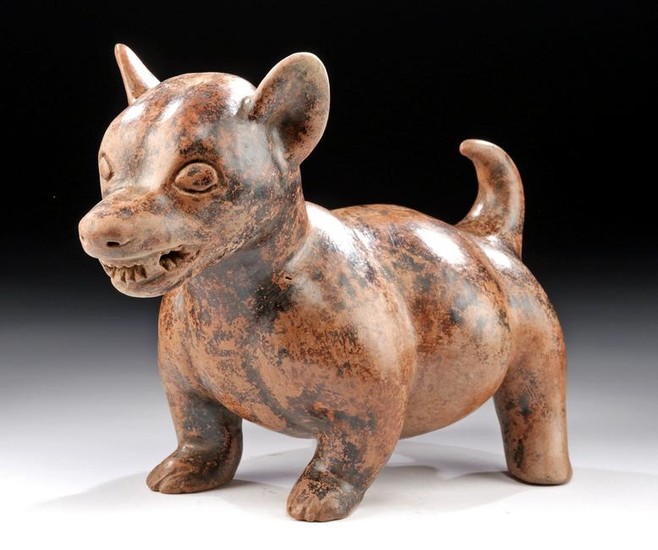Fine Colima Redware Dog Effigy Vessel
Pre-Columbian, West Mexico, Colima, Protoclassic period, ca. 100 BCE to 250 CE. One of the most famous of the classes of West Mexican shaft tomb culture artifacts, a hollow-built pottery effigy sculpture depicting a rotund canine. The dog is defined by a portly abdomen supported by four attenuated legs, a stocky neck, a tapered head, and a conical tail projecting off of the back. The intimidating countenance features incised almond-shaped eyes, a perky nose, tab-shaped ears, and two rows of gnashing teeth; the vessel's 'spout' is through the mouth. The exterior surfaces are embellished with orange-red slip that has faded to a vibrant orange hue over time. A fine example from ancient West Mexico! Size: 11.625" L x 6" W x 7.9" H (29.5 cm x 15.2 cm x 20.1 cm).
Scholars know of at least two types of Colima dogs, one to be fattened up and ritually sacrificed or eaten and one to serve as a watchdog and healer of the ill. This plump hairless canine known as a Chichi or Escuintla is thought to be related to the Chihuahua or Mexican Hairless also known as the Xoloitzcuintle. The Xolo dog was named for the deity Xolotl, the God of the Underworld, and believed to guide the deceased as they journeyed to the afterlife. Colima vessels such as this one were buried in shaft tombs to protect the deceased and provide sustenance for eternity.
For a stylistically similar example with a vibrant red surface color, please see the Los Angeles County Museum of Art, accession number M.72.116.
Another stylistically similar example, of a larger size, hammered for $8,750 at Sotheby's, New York "African, Oceanic and Pre-Columbian Art Including Property from the Pierre and Tana Matisse Foundation" auction (May 13, 2011, lot 158).
Provenance: private Carlsbad, California, USA collection
All items legal to buy/sell under U.S. Statute covering cultural patrimony Code 2600, CHAPTER 14, and are guaranteed to be as described or your money back.
A Certificate of Authenticity will accompany all winning bids.
We ship worldwide to most countries and handle all shipping in-house for your convenience.
#150171
Condition Report: Repair and possible restoration to parts of both ears and tail, with resurfacing and overpainting along new material and break lines, but nearly invisible and unobtrusive to the vessel's presentation. Minor abrasions to limbs, body, and head, with fading to original orange-red slip pigment, and light encrustations. Great earthen deposits and nice traces of original pigment throughout.
View it on
Estimate
Time, Location
Auction House
Pre-Columbian, West Mexico, Colima, Protoclassic period, ca. 100 BCE to 250 CE. One of the most famous of the classes of West Mexican shaft tomb culture artifacts, a hollow-built pottery effigy sculpture depicting a rotund canine. The dog is defined by a portly abdomen supported by four attenuated legs, a stocky neck, a tapered head, and a conical tail projecting off of the back. The intimidating countenance features incised almond-shaped eyes, a perky nose, tab-shaped ears, and two rows of gnashing teeth; the vessel's 'spout' is through the mouth. The exterior surfaces are embellished with orange-red slip that has faded to a vibrant orange hue over time. A fine example from ancient West Mexico! Size: 11.625" L x 6" W x 7.9" H (29.5 cm x 15.2 cm x 20.1 cm).
Scholars know of at least two types of Colima dogs, one to be fattened up and ritually sacrificed or eaten and one to serve as a watchdog and healer of the ill. This plump hairless canine known as a Chichi or Escuintla is thought to be related to the Chihuahua or Mexican Hairless also known as the Xoloitzcuintle. The Xolo dog was named for the deity Xolotl, the God of the Underworld, and believed to guide the deceased as they journeyed to the afterlife. Colima vessels such as this one were buried in shaft tombs to protect the deceased and provide sustenance for eternity.
For a stylistically similar example with a vibrant red surface color, please see the Los Angeles County Museum of Art, accession number M.72.116.
Another stylistically similar example, of a larger size, hammered for $8,750 at Sotheby's, New York "African, Oceanic and Pre-Columbian Art Including Property from the Pierre and Tana Matisse Foundation" auction (May 13, 2011, lot 158).
Provenance: private Carlsbad, California, USA collection
All items legal to buy/sell under U.S. Statute covering cultural patrimony Code 2600, CHAPTER 14, and are guaranteed to be as described or your money back.
A Certificate of Authenticity will accompany all winning bids.
We ship worldwide to most countries and handle all shipping in-house for your convenience.
#150171
Condition Report: Repair and possible restoration to parts of both ears and tail, with resurfacing and overpainting along new material and break lines, but nearly invisible and unobtrusive to the vessel's presentation. Minor abrasions to limbs, body, and head, with fading to original orange-red slip pigment, and light encrustations. Great earthen deposits and nice traces of original pigment throughout.



